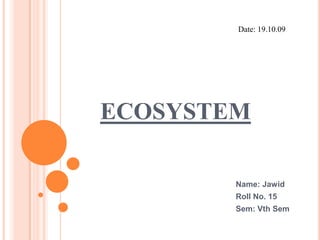An ecosystem is defined as a dynamic complex of plant, animal, and microorganism communities interacting with their non-living environment as a functional unit. Ecosystems can be classified using physiognomic-ecological systems that describe vegetation structures and cover, taking into account ecological factors like climate, elevation, and seasonality. Several classification systems are available for different ecosystem types, both terrestrial and aquatic. Ecosystems are not discrete units that can be simply delineated, as any classification involves observer input and normative rationale.

![An ecosystem is a system of interdependent organisms which share the same habitat, in an area functioning together with all of the physical (abiotic) factors of the environment. Ecosystems can be permanent or temporary. Ecosystems usually form a number of food webs.ClassificationEcosystems have become particularly important politically, since the Convention on Biological Diversity (CBD) - ratified by more than 175 countries - defines "the protection of ecosystems, natural habitats and the maintenance of viable populations of species in natural surroundings"[5] as a commitment of ratifying countries. This has created the political necessity to spatially identify ecosystems and somehow distinguish among them. The CBD defines an "ecosystem" as a "dynamic complex of plant, animal and micro-organism communities and their non-living environment interacting as a functional unit".](https://image.slidesharecdn.com/ecosystem-100629063004-phpapp01/85/Ecosystem-2-320.jpg)

![Several physiognomic-ecological classification systems are available:Physiognomic-Ecological Classification of Plant Formations of the Earth: a system based on the 1974 work of Mueller-Dombois and Heinz Ellenberg[6], and developed by UNESCO. It describes the above-ground or underwater vegetation structures and cover as observed in the field, described as plant life forms. This classification is fundamentally a species-independent physiognomic, hierarchical vegetation classification system which also takes into account ecological factors such as climate, elevation, human influences such as grazing, hydric regimes, and survival strategies such as seasonality. The system was expanded with a basic classification for open water formations.[7]Land Cover Classification System (LCCS), developed by the Food and Agriculture Organization (FAO).[8]Forest-Range Environmental Study Ecosystems (FRES) developed by the United States Forest Service for use in the United States.[9]Several aquatic classification systems are available, and an effort is being made by the United States Geological Survey (USGS) and the Inter-American Biodiversity Information Network (IABIN) to design a complete ecosystem classification system that will cover both terrestrial and aquatic ecosystems.](https://image.slidesharecdn.com/ecosystem-100629063004-phpapp01/85/Ecosystem-4-320.jpg)


